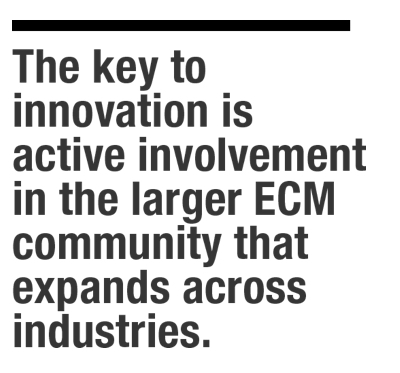
©2017 DOCUMENT Strategy Media
Enterprise content management (ECM) implementations experienced rapid growth and significant client investments from the late 90s through the financial downturn of 2008. With the reduction in storage costs as well as innovation brought about by robust networks, computers, and Internet browsers, organizations were finally free to truly capture the promise of ECM. Whether leveraging internal resources or working with outside consultants, ECM customers were able to build out purpose-driven solutions on Documentum, OpenText, FileNet/IBM, or other ECM platforms.
With the downturn of 2008 and beyond, many of these systems were left in a stable state, where customers and information technology (IT) departments chose a minimal maintenance approach or made small additions to get the most out of their significant ECM investment. Flash forward to 2016, while the legacy ECM system investment has paid itself off and then some, customers are finding that they are stuck in the middle—either making the expensive choice to upgrade, migrating to a new system, or saving money by sticking with their current and clunky legacy ECM implementation.
Some issues with this can include:
- Resources (both technical and business) that designed and developed the old system are long gone.
- Integrations with other corporate systems, which have been added over the years, make it difficult to simply “rip and replace” the legacy ECM system.
- Technology, specifically browser-based solutions, are no longer supported. We have seen clients struggle with Chrome or delay Internet Explorer (IE) upgrades due to incompatibilities with their legacy ECM application.
Adding innovation one step at a time
Innovative ECM customers are adding improvements to their legacy ECM system “one bite at a time.” Some examples include:Consumer-focused Interface: Many of the legacy ECM systems take a “one size fits all” interface, where consumer users of search and retrieval must use the same interface as authors and approvers. Typically, we have seen that 80% or more of ECM users are just consumers. Innovative clients are creating or buying simplified consumer-only interfaces focused on search and retrieval, giving the majority of their customers a better experience with a new and improved interface.
Consumer Publishing Architectures: Taking the consumer interface one step further, innovative clients are leveraging cheap computing and storage to build publishing architectures that copy and push content from the legacy ECM system to a separate system with a consumer interface. Focused on retrieval, we have seen customers leverage Lucene/Solr as well as Hadoop to keep the cost of the receiving system to a minimum. The added benefits of a publishing approach include business continuity, performance, integration possibilities (pushing from multiple repositories), decreased downtime during migrations and upgrades, as well as reduced ECM licensing cost.

Approver-focused Add-ons: Similar to the consumer approach, approvers also want something easy and intuitive. Moving from the one-size-fits-all interface to a focused and intuitive approval interface can improve the user experience for this key group of stakeholders.
New Hardware/Cloud: Minimal maintenance approaches typically leave legacy systems on legacy infrastructure. Moving the legacy system back-end doesn’t always have to involve changing the front-end or other integrations. Innovative customers are taking advantage of new virtualized capabilities in their own data center or the Amazon and Microsoft cloud.
Browser-based Viewing and Annotations: For Legacy ECM systems, viewing and adding annotations to documents required expensive and difficult-to-maintain proprietary plug-ins. Over the years, with the power of modern browsers, these plug-ins can be retired with a move to a more robust interface, which is significantly easier to maintain.
Replace Non-core “Suite” Products: Over the past 10 to 15 years, the ECM industry has gone through a consolidation phase, with most of the major legacy ECM vendors purchasing companies that provide supportive services (scanning, workflow, reporting, etc.). The products these vendors purchased weren’t always best of breed and might not have received the investment that was promised when the purchase was announced. Innovative clients are looking at alternatives outside of the vendor suite, particularly at open source alternatives.
Innovation begins with collaboration
One last suggestion for legacy ECM customers looking for innovation: Focus on learning and expanding on the experiences of the overall ECM community. Too often, customers are stuck within their own company or industry. The key to innovation is active involvement in the larger ECM community that expands across industries. Innovative alternatives can be discovered via social media, forums, as well as conferences—where ECM customers and evangelists can share their experiences.For more information on innovative ECM approaches, don't miss our special session, "Beyond the Big Three: Alternative ECM Technologies," at DSF ’17, May 1-3, 2017 in Downtown Chicago.
Dave Giordano is the Founder and President of Technology Services Group (TSG), a Chicago technology consulting firm with 40+ enterprise content management (ECM) consultants. Previous to founding TSG in 1996, Dave worked for nine years for Accenture (Andersen Consulting). Follow the TSG Blog or follow them on Twitter @tsgrp.









